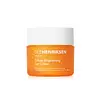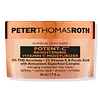What's inside
What's inside
 Key Ingredients
Key Ingredients

 Benefits
Benefits

 Concerns
Concerns

 Ingredients Side-by-side
Ingredients Side-by-side

Water
Skin ConditioningGlycerin
HumectantDicaprylyl Carbonate
EmollientPropanediol
SolventCaprylic/Capric Triglyceride
Masking3-O-Ethyl Ascorbic Acid
Skin ConditioningGlycereth-26
HumectantAmmonium Acryloyldimethyltaurate/Beheneth-25 Methacrylate Crosspolymer
Emulsion StabilisingHydrolyzed Jojoba Esters
Skin ConditioningCetearyl Alcohol
EmollientPolyacrylate Crosspolymer-6
Emulsion StabilisingHydroxyacetophenone
AntioxidantPanthenol
Skin ConditioningPolyglyceryl-3 Methylglucose Distearate
EmulsifyingTetrahexyldecyl Ascorbate
AntioxidantLinoleic Acid
CleansingCitric Acid
BufferingPhenoxyethanol
PreservativeParfum
MaskingPentaerythrityl Tetra-Di-T-Butyl Hydroxyhydrocinnamate
AntioxidantXanthan Gum
EmulsifyingCetearyl Glucoside
EmulsifyingLinolenic Acid
CleansingCitrus Aurantium Dulcis Fruit Extract
MaskingCitrus Limon Fruit Extract
MaskingHippophae Rhamnoides Extract
MaskingLycium Barbarum Fruit Extract
AstringentRosa Canina Fruit Extract
AstringentEthylhexylglycerin
Skin ConditioningLeuconostoc/Radish Root Ferment Filtrate
AntimicrobialSodium Citrate
BufferingCamellia Japonica Flower Extract
EmollientAroma
Sodium Hyaluronate
HumectantSodium Polyacrylate
AbsorbentSodium Phytate
Hyaluronic Acid
HumectantTriacetin
AntimicrobialHydrolyzed Vegetable Protein
Skin ConditioningAscorbic Acid
AntioxidantTocopherol
AntioxidantLimonene
PerfumingLinalool
PerfumingBenzyl Alcohol
PerfumingCI 15985
Cosmetic ColorantCI 19140
Cosmetic ColorantWater, Glycerin, Dicaprylyl Carbonate, Propanediol, Caprylic/Capric Triglyceride, 3-O-Ethyl Ascorbic Acid, Glycereth-26, Ammonium Acryloyldimethyltaurate/Beheneth-25 Methacrylate Crosspolymer, Hydrolyzed Jojoba Esters, Cetearyl Alcohol, Polyacrylate Crosspolymer-6, Hydroxyacetophenone, Panthenol, Polyglyceryl-3 Methylglucose Distearate, Tetrahexyldecyl Ascorbate, Linoleic Acid, Citric Acid, Phenoxyethanol, Parfum, Pentaerythrityl Tetra-Di-T-Butyl Hydroxyhydrocinnamate, Xanthan Gum, Cetearyl Glucoside, Linolenic Acid, Citrus Aurantium Dulcis Fruit Extract, Citrus Limon Fruit Extract, Hippophae Rhamnoides Extract, Lycium Barbarum Fruit Extract, Rosa Canina Fruit Extract, Ethylhexylglycerin, Leuconostoc/Radish Root Ferment Filtrate, Sodium Citrate, Camellia Japonica Flower Extract, Aroma, Sodium Hyaluronate, Sodium Polyacrylate, Sodium Phytate, Hyaluronic Acid, Triacetin, Hydrolyzed Vegetable Protein, Ascorbic Acid, Tocopherol, Limonene, Linalool, Benzyl Alcohol, CI 15985, CI 19140
Water
Skin ConditioningTetrahexyldecyl Ascorbate
AntioxidantPropanediol
SolventC9-12 Alkane
SolventGlycerin
HumectantTocopheryl Acetate
AntioxidantBehenyl Alcohol
EmollientPalmitic Acid
EmollientCetyl Palmitate
EmollientPolyglyceryl-2 Stearate
EmulsifyingStearic Acid
CleansingStearyl Alcohol
EmollientOleic Acid
EmollientSoy Acid
EmollientFerulic Acid
AntimicrobialBrassica Oleracea Acephala Leaf Extract
HumectantOlea Europaea Fruit Extract
BleachingHydrolyzed Collagen
EmollientElastin
Skin ConditioningZingiber Officinale Root Extract
MaskingLactic Acid
BufferingCeramide NP
Skin ConditioningSodium Hyaluronate
HumectantButyrospermum Parkii Butter
Skin ConditioningWheat Amino Acids
Skin ConditioningGlycine Soja Sterols
EmollientSaccharomyces Ferment
Skin ConditioningJojoba Esters
EmollientOlus Oil
EmollientGlyceryl Stearate
EmollientGluconolactone
Skin ConditioningCalcium Gluconate
HumectantSodium Benzoate
MaskingSodium PCA
HumectantSodium Stearoyl Lactylate
EmulsifyingMyristic Acid
CleansingSodium Hydroxide
BufferingSodium Lactate
BufferingLauroyl Lysine
Skin ConditioningArachidic Acid
CleansingLauric Acid
CleansingPotassium Sorbate
PreservativeCoco-Caprylate/Caprate
EmollientSodium Carboxymethyl Beta-Glucan
CleansingHistidine Hcl
Skin ConditioningCarnosine
Skin ConditioningPolyglyceryl-6 Distearate
EmulsifyingArachidyl Alcohol
EmollientCetyl Alcohol
EmollientLauryl Alcohol
EmollientXanthan Gum
EmulsifyingCarbomer
Emulsion StabilisingPolyglyceryl-3 Beeswax
EmulsifyingEthylhexylglycerin
Skin ConditioningDisodium EDTA
Mica
Cosmetic ColorantPhenoxyethanol
PreservativeCI 15985
Cosmetic ColorantCI 19140
Cosmetic ColorantWater, Tetrahexyldecyl Ascorbate, Propanediol, C9-12 Alkane, Glycerin, Tocopheryl Acetate, Behenyl Alcohol, Palmitic Acid, Cetyl Palmitate, Polyglyceryl-2 Stearate, Stearic Acid, Stearyl Alcohol, Oleic Acid, Soy Acid, Ferulic Acid, Brassica Oleracea Acephala Leaf Extract, Olea Europaea Fruit Extract, Hydrolyzed Collagen, Elastin, Zingiber Officinale Root Extract, Lactic Acid, Ceramide NP, Sodium Hyaluronate, Butyrospermum Parkii Butter, Wheat Amino Acids, Glycine Soja Sterols, Saccharomyces Ferment, Jojoba Esters, Olus Oil, Glyceryl Stearate, Gluconolactone, Calcium Gluconate, Sodium Benzoate, Sodium PCA, Sodium Stearoyl Lactylate, Myristic Acid, Sodium Hydroxide, Sodium Lactate, Lauroyl Lysine, Arachidic Acid, Lauric Acid, Potassium Sorbate, Coco-Caprylate/Caprate, Sodium Carboxymethyl Beta-Glucan, Histidine Hcl, Carnosine, Polyglyceryl-6 Distearate, Arachidyl Alcohol, Cetyl Alcohol, Lauryl Alcohol, Xanthan Gum, Carbomer, Polyglyceryl-3 Beeswax, Ethylhexylglycerin, Disodium EDTA, Mica, Phenoxyethanol, CI 15985, CI 19140
Ingredients Explained
These ingredients are found in both products.
Ingredients higher up in an ingredient list are typically present in a larger amount.
Ci 15985 is a dye made from petroleum. It is synthetically created and approved by the FDA for use in foods and cosmetics.
The color of this dye is orange/yellow.
This ingredient can be found in makeup, sun care, and skincare.
Learn more about CI 15985CI 19140 is also known as Tartrazine. Tartrazine is a synthetic dye used in cosmetics, foods, and medicine to add a yellow color.
Tartrazine is created from petroleum and is water-soluble.
Some people may experience allergies from this dye, especially asthmatics and those with an aspirin intolerance.
Learn more about CI 19140Ethylhexylglycerin (we can't pronounce this either) is commonly used as a preservative and skin softener. It is derived from glyceryl.
You might see Ethylhexylglycerin often paired with other preservatives such as phenoxyethanol. Ethylhexylglycerin has been found to increase the effectiveness of these other preservatives.
Glycerin is already naturally found in your skin. It helps moisturize and protect your skin.
A study from 2016 found glycerin to be more effective as a humectant than AHAs and hyaluronic acid.
As a humectant, it helps the skin stay hydrated by pulling moisture to your skin. The low molecular weight of glycerin allows it to pull moisture into the deeper layers of your skin.
Hydrated skin improves your skin barrier; Your skin barrier helps protect against irritants and bacteria.
Glycerin has also been found to have antimicrobial and antiviral properties. Due to these properties, glycerin is often used in wound and burn treatments.
In cosmetics, glycerin is usually derived from plants such as soybean or palm. However, it can also be sourced from animals, such as tallow or animal fat.
This ingredient is organic, colorless, odorless, and non-toxic.
Glycerin is the name for this ingredient in American English. British English uses Glycerol/Glycerine.
Learn more about GlycerinPhenoxyethanol is a preservative that has germicide, antimicrobial, and aromatic properties. Studies show that phenoxyethanol can prevent microbial growth. By itself, it has a scent that is similar to that of a rose.
It's often used in formulations along with Caprylyl Glycol to preserve the shelf life of products.
Propanediol is an all-star ingredient. It softens, hydrates, and smooths the skin.
It’s often used to:
Propanediol is not likely to cause sensitivity and considered safe to use. It is derived from corn or petroleum with a clear color and no scent.
Learn more about PropanediolSodium Hyaluronate is hyaluronic acid's salt form. It is commonly derived from the sodium salt of hyaluronic acid.
Like hyaluronic acid, it is great at holding water and acts as a humectant. This makes it a great skin hydrating ingredient.
Sodium Hyaluronate is naturally occurring in our bodies and is mostly found in eye fluid and joints.
These are some other common types of Hyaluronic Acid:
Learn more about Sodium HyaluronateTetrahexyldecyl Ascorbate (THD) is a stable and oil-soluble form of Vitamin C.
THD is special in that it has the ability to travel deeper into skin than traditional ascorbic acid while maintaining the same skin benefits (double win!).
Because it’s oil-soluble, THD dives deep into your skin’s fatty layers (think ceramides and cholesterol) to fight off the kind of free radicals that mess with your skin barrier. This makes it a great pair with water-based vitamin C (ascorbic acid) that mainly works on the surface.
Even at just 0.1%, THD is already showing great antioxidant activity. When used up to 2%, it helps keep your skin happy and calm, especially when it’s stressed from pollution or sun.
Want to fade dark spots or tackle hyperpigmentation? You’ll want 5% or more. Pairing it with brightening buddies like niacinamide or licorice root gives even better results. One study even used 30% THD with other brighteners and saw real results on stubborn discoloration, even in melasma-prone skin.
A note on THD: It’s has a slightly silky, oily texture and usually shows up colorless or pale yellow (though the exact shade can vary by supplier).
While you can sneak it into water-based formulas, it really shines when paired with silicones or oils, which help your skin soak it up better.
THD is pretty stable, but it’s still vulnerable to degradation like ascorbic acid. Too much light or heat (above 113°F / 45°C) can break it down over time. Go for dark and opaque packaging that keeps it safe and shady!
Read more about other types of Vitamin C:
Learn more about Tetrahexyldecyl AscorbateWater. It's the most common cosmetic ingredient of all. You'll usually see it at the top of ingredient lists, meaning that it makes up the largest part of the product.
So why is it so popular? Water most often acts as a solvent - this means that it helps dissolve other ingredients into the formulation.
You'll also recognize water as that liquid we all need to stay alive. If you see this, drink a glass of water. Stay hydrated!
Learn more about WaterXanthan gum is used as a stabilizer and thickener within cosmetic products. It helps give products a sticky, thick feeling - preventing them from being too runny.
On the technical side of things, xanthan gum is a polysaccharide - a combination consisting of multiple sugar molecules bonded together.
Xanthan gum is a pretty common and great ingredient. It is a natural, non-toxic, non-irritating ingredient that is also commonly used in food products.
Learn more about Xanthan Gum